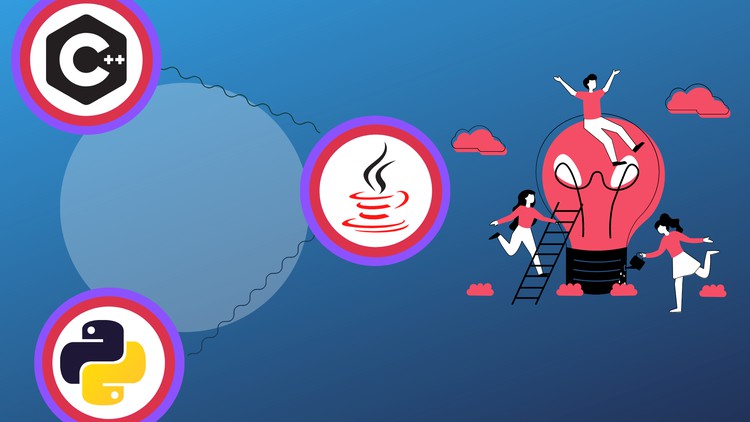Java And C++ And Python Programming In Complete Course
Learn Java Programming, C++ Programming, and Python Programming all at the same time in a single course!
What you’ll learn
Java And C++ And Python Programming In Complete Course
- An introduction to C++ and Java programming as well as Python programming as a whole.
- C++, Java, and Python concepts are shown in real-world situations.
- Learn about C++, Java, and Python programming for the software’s interface, as well as Python programming for the software’s interface.
- You can learn C++ and Java’s Arrays, Lists, and Structured Data Class.
- Make sure you know how to use java operators, types of data, and conditionals.
- Take a look at Python conditional statements, loops, and other statements and learn them.
- Python operators, Python datatypes, and Python functional statements are all things you should learn about, so keep reading.
Requirements
- Basic computer skills
- To learn C++, Java, and Python programming, you don’t need to know how to write code.
Description
Beginners will learn everything they need to know about C++, Java, and Python.
Why this class:
- Applying what you learned: 9 hours
- There is a lot of practice coding and making things work in each tutorial
- The ability to learn at your own pace for life.
- In C++, Java, and Python, you can work in many different fields.
1) Java: The Complete Course
This advanced Java Certification Training is meant to teach you everything you need to know about Java, from how to write simple programs to how to write complex ones. This Java course will also teach you about Core Java 8, operators, arrays, loops, methods, and constructors. It will also give you hands-on experience with the java programming language, so you can learn how to write programs.
You’ll learn about the basics of Java programming in this class. Using the Java Development Kit 6 SE, students will learn how to format objects in a basic way so they can move on to more complex classes.
Java Remote Method Invocation, socket-based network programming, I/O files, serialization, and the Java runtime environment are all covered in this course, as well as Java Remote Method Invocation (RMI). Students in this class also learn how to use native methods, threads, and synchronization.
During this class, students will learn how to write programs that will solve problems in the real world. When they finish this class, they should be able to design software that can solve problems on a large scale.
This class helps students learn more about Java programming. As a result, those who sign up will learn how to work with and read data with a more complicated structure.
2) C++ is a full course.
During this class, you will learn about the C++ programming language and its subset, the C++ programming language. Among the topics covered in this class: The program’s structure and blocks; storage types; console and file I/O; functions; arrays; strings; pointers; call by reference; call by value, and dynamic memory allocation will be talked about. The concept and use of classes will be talked about in some detail in this class. The differences between C++ will also be talked about.
The goal of this class is to teach students about the C++ programming language and teach them about basic and intermediate programming concepts with examples and applications that use the C++ language. ITSE 2431 (Advanced C++ Programming) and COSC 2415 (Data Structures) are two more advanced programming courses that students can take after COSC 1315. They also prepare them for entry-level programming jobs. To get an Associate Degree in some Computer Information Systems and Computer Science fields, you need to take this class.
THE OUTCOMES/OBJECTIVES THAT STUDENTS ACHIEVE
The following are the goals and learning outcomes of the course:
- Modular programming can be shown off by making programs that need to use programmer-defined functions.
- Then, show that you know a lot about arrays by making and testing programs that can search and sort arrays.
- Use overloaded functions and constructors to show that you know a lot about object-oriented programming concepts like encapsulation, data abstraction, and composition by making and using classes.
- Programs that use pointers and dynamic memory allocation should show that you know a lot about the concept of pointers and how they work.
- Programmer-defined functions and classes can be written code, tested, and debugged in a variety of complex programs to show that you know how they work.
- In all of the programs you write in this class, show off a good documentation style.
- When you finish this course, you should be able to write data validation code, perform unit tests, and write test plans for your projects.
- For both the console and files, show that you know a lot about how to stream input and output work.
- Use C++ strings, structs, and classes in programs to show that you know how C++ is different from C++ when it comes to strings, pass-by-reference (passing pointers), and structs.
Learn in this class.
- To learn how to write good C++ programs, you need to learn about the basic programming concepts and techniques that are important.
- Learn how to write programs in the C++ programming language through lab experiences.
- To write, document, test, and build a well-structured, strong computer program with the /C++ programming language.
3) Python is the programming language.
Python is a language that has a simple syntax and a lot of powerful tools for writing code. It is an interpreted language that has a lot of tools for programming, like a debugger and a profiler. While it is easy for beginners to learn, it is used in many scientific fields to look at data. This part of the class is about programming and the python language. Students learn about the basics of python programming, such as conditionals, loops, variables, and functions, in this class. This section gives a general overview of the different parts of Python. Hands-on coding exercises are also available. They teach you how to write custom functions, read and write to files, and more. This section or the whole course may be more robust than some other courses because it goes more in-depth into some important programming topics that other courses don’t.
Who this course is for:
- As a guide for people who don’t know much about C++ and Java and Python.
- Who wants to learn the basics of C++ and Java and then move on to become a software developer?










